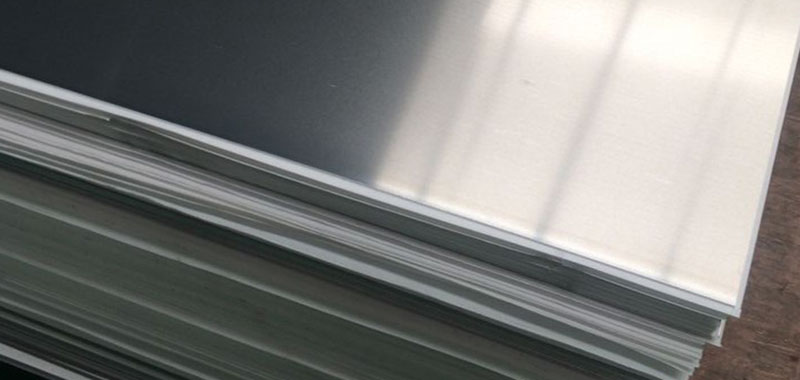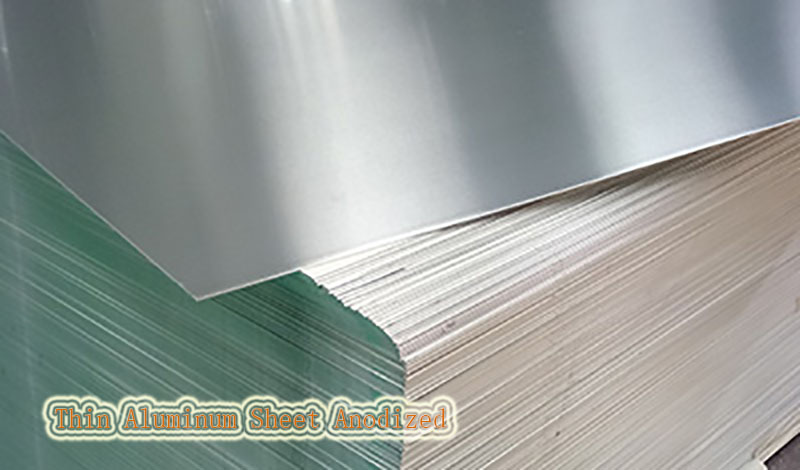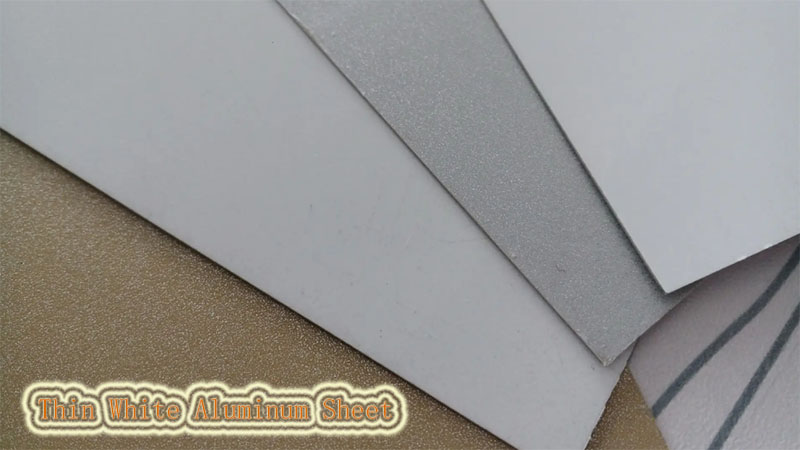Thin aluminum sheets refer to aluminum sheets with a relatively small thickness. The specific thickness may vary according to the intended application and requirements.

Generally, thin aluminum sheet is defined as aluminum sheet that is less than 1/8 inch (3.175 mm) thick. Here are some common examples:
- Foil: Aluminum foil is the thinnest sheet of aluminum, typically less than 0.2 mm (0.008 in.) thick. It is used in packaging, wrapped food, insulation and other specialized applications.
- Thin Gauge Aluminum Sheet: Thin gauge aluminum sheet is typically 0.2mm to 2.0mm (0.008 to 0.08 inches) thick. They are commonly used for signage, crafts, lightweight construction and decorative purposes.
- Thin Aluminum Sheet for Electronics: In the electronics industry, thin aluminum sheets are used in applications such as circuit boards, heat sinks, and electronic enclosures. Thickness can range from 0.1mm to 1.0mm (0.004 to 0.04 inches) or thinner, depending on the specific component.
- Thin Aluminum Sheet for Automotive: Thin aluminum sheets are used for lightweight body panels, interior trim, and other components in automotive applications. Thickness ranges from 0.5 mm to 2.0 mm (0.02 to 0.08 in.) depending on the specific part and its construction requirements.
Typical Thin Aluminum Sheet
Thin Aluminum Sheet 4x8
- Alloys: Alloys used for 4x8 size sheet aluminum can vary, but typically include 3003 or 5052 aluminum alloys.
- Temper: The temper of the alloy is usually the annealed (O) or H14 temper, which provides good formability and moderate strength.
- Specifications: 4x8 size sheet aluminum sheet thickness ranges from 0.025 to 0.125 inches (0.64 to 3.18mm). Measures 4 feet (48 inches) wide and 8 feet (96 inches) long.
- Surface treatment: Surface treatment can be polished or coated with protective film.
- Common Uses: 4x8 Dimensions Sheet Aluminum is commonly used in a variety of applications such as signage, wall cladding, roofing, trailer siding, and general fabrication.

Thin Aluminum Sheet Anodized
- Alloy: Anodized aluminum panels are usually made from 5005 or 6061 aluminum alloys.
- Condition: Aluminum alloy can be in annealed (O) or H32 tempered condition.
- Specifications: Thin anodized aluminum sheets range in thickness from 0.025 to 0.125 inches (0.64 to 3.18 mm). Width and length can vary according to specific requirements.
- Surface treatment: Anodized aluminum panels undergo an electrochemical process called anodizing, which creates a durable, decorative oxide layer on the surface. Anodizing offers increased corrosion resistance, increased hardness and a variety of color options.
- Common uses: Thin anodized aluminum sheets are commonly used for architectural elements, decorative applications, nameplates, electronic enclosures, and automotive trim.

Thin Gauge Aluminum Diamond Plate
- Alloy: 3003 aluminum alloy is usually used for thin gauge aluminum diamond plate.
- Condition: Aluminum alloy is in H22 or H24 tempered condition, with good strength and workability.
- Gauge: Thin gauge aluminum diamond plates range in thickness from 0.025 to 0.125 inches (0.64 to 3.18 mm). The size of the diamond pattern may vary by specific product.
- Surface Treatment: The surface of thin gauge aluminum diamond plates is often embossed with a raised diamond pattern in the metal for added traction and aesthetics. The board may have a satin finish or be coated with a protective film.
- Common Uses: Thin gauge diamond shaped aluminum sheet is commonly used in flooring, stairs, ramps, truck beds, tool boxes, and trim applications where slip resistance and durability are required.
Thin White Aluminum Sheet
- Alloy: 3003 or 3105 aluminum alloy is usually used for thin white aluminum plate.
- State: Aluminum alloy is generally in H14 or H24 tempered state, with good formability and medium strength.
- Specifications: Thin white aluminum sheets range in thickness from 0.025 to 0.125 inches (0.64 to 3.18 mm). Width and length can vary according to specific requirements.
- Surface treatment: The surface of the thin white aluminum sheet can be painted with white paint, or it can be coated with white polyester or PVDF (polyvinylidene fluoride) to provide a durable and attractive appearance.
- Common Uses: Thin white aluminum sheets are commonly used for interior and exterior cladding, signage, architectural trim, and other decorative applications that require a clean, white appearance.

Thin Aluminum Sheet With Holes
- Alloy: 3003 aluminum alloy is commonly used for perforated thin aluminum sheet.
- Temper: H14/H24, these tempered tempers provide good formability and moderate strength.
- General corresponding specifications:
- Thickness: From 0.025 to 0.125 inches (0.64 to 3.18 mm).
- The size, spacing and pattern of holes in the sheet can be customized according to the intended purpose.
- Surface treatment: polished, anodized, powder coated.
-
Specific application examples:
- HVAC Vents: Sheet aluminum (alloy 3003), 0.040 in. thick, with regularly spaced round holes, ground finish. For commercial and residential HVAC systems.
- Speaker Grille: Sheet aluminum (3003 alloy), 0.080 in. thick with hexagonal holes, anodized. For audio systems and speakers.
- Trim Panel: Sheet aluminum (alloy 3003), 0.063" thick with custom shaped holes, powder-coated white finish. For architectural decoration and interior design.
- Liquid Filter Media: Sheet aluminum (alloy 3003), 0.025" thick with small rectangular holes, anodized. For industrial filtration systems.
- Automotive Grille: Sheet aluminum (alloy 3003), 0.125" thick, with elongated slots, powder-coated black. Used on car grilles for added beauty and airflow.

How to Weld Thin Aluminum Sheet
Welding thin aluminum sheets requires careful attention and precise technique to avoid warping or damaging the material. The following are general guidelines on how to weld thin aluminum sheets using tungsten inert gas (TIG) welding:
Prepare Materials
Thoroughly clean the aluminum panels to remove any dirt, grease or oxides. Use a wire brush, sandpaper, or a special aluminum cleaner.
Trim the sheets and install them into the desired joint configuration, ensuring tight alignment and minimal gaps.
To set up the Welding Equipment
Choose a TIG welder suitable for welding thin aluminum sheets. Make sure it has adjustable settings for current, airflow, and tungsten electrode size.
Fit a suitable tungsten electrode, usually made of pure tungsten or a tungsten alloy, and grind it to a sharp tip.
Choose the Right Shielding Gas
Use pure argon or a helium-argon mixture as shielding gas. Argon provides good coverage and stability for TIG welding aluminum.
Adjust Welding Parameters
Set the welder to the appropriate amperage range, usually lower for thin aluminum sheets. Consult the manufacturer's guide or seek professional advice for recommended settings.
Adjust the gas flow rate to provide adequate shield coverage. Typically, a flow rate of about 10-15 cubic feet per hour (CFH) is suitable for welding thin aluminum.
Welding Technology
Point the TIG torch at a 10-15 degree angle to the surface, pointing in the direction of welding.
The arc is initiated by briefly striking a tungsten electrode on the workpiece.
Maintaining a steady travel speed, move the torch along the joint in a controlled manner. Avoid living in one place to prevent overheating.
When welding, add filler metal to the joint as needed. Use a filler rod that is compatible with the aluminum alloy you are welding and match it to the thickness of the sheet.
Heat input is controlled by adjusting the amperage and the distance between the torch and the workpiece. Too much heat can warp or burn through the thin aluminum sheet.
After Welding
Allow the welded area to cool slowly to minimize stress and prevent distortion.
Use a wire brush or other suitable tool to remove any residue or discoloration from the weld.
It is crucial to practice on scrap and perfect your technique before welding on actual thin aluminum sheets. Also, consider seeking instruction from an experienced welder or taking a welding class to further improve your skills in welding thin aluminum sheets.

